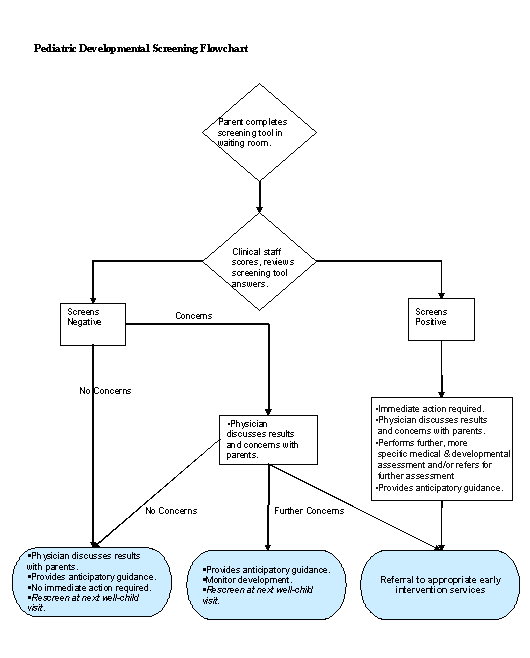 |

The Role of the Primary Health Care Provider in
Children’s Developmental Health
Developmental screening can be done by a number of professionals in health
care, community, and school settings. Two reasons primary health care
providers are in a unique position to promote children’s developmental
health are:
-
Primary care providers have regular contact with children before they reach
school age. In 2002, 86% of insured children and 71% of uninsured children
younger than 6 years of age had a well-child visit with a health
professional in the past year. Such visits allow developmental and other
health problems to be identified and treated early in a child’s life.
Whether a problem is medical or behavioral, or both, finding it early and
treating it can greatly improve the child’s chances of reaching his or her
full potential for physical, mental, and social health and well-being.
-
Primary care providers are able to provide family-centered, comprehensive,
coordinated care, including a more complete medical assessment when a
screening indicates a child is at risk for a developmental problem. The
provider may further assess the child for a diagnosable developmental
condition(s) (for example, a language disorder,
attention-deficit/hyperactivity disorder, autism, mental retardation), and
for potential coexisting neurologic, metabolic, or genetic disorders that
might require specific treatments or interventions of their own. In some
cases, the primary care provider might choose to refer the child and family
to a specialist for further assessment and diagnosis, such as to a
neurodevelopmental pediatrician, a developmental-behavioral pediatrician, a
child neurologist, a geneticist, or an early intervention program that
provides assessment services.
For current American Academy of Pediatrics clinical practice
recommendations for developmental screening, visit
Developmental Surveillance and Screening of Infants and Young Children.
1Child Trends et al. Early child development in social context:
a chartbook. Child Trends, The Commonwealth Fund and Center for Child
Health Research; September 2004.
Integrating
Developmental Screening into Pediatric/Primary Care Practice
Integrating routine developmental screening into the practice setting can
seem daunting. In a 2001
American Academy of Pediatrics (AAP) Periodic Survey of Fellows,
pediatricians cited time limitation as the number one barrier to
developmental screening. Billing, reimbursement, and staff issues were
other primary barriers.
Following are tips for integrating screening services into primary care
efficiently and at low cost, while ensuring thorough coordination of care.
Involving Families in Screening
Research indicates that parents are reliable sources of information about
their children’s development. Evidence-based screening tools that
incorporate parent reports (e.g., Ages and Stages Questionnaire, the
Parent’s Evaluation of Developmental Status, and Child Development
Inventories) can facilitate structured communication between parents and
providers so as to elicit parent concerns, increase parent and provider
observations of the child’s development, and increase parent awareness.
Such tools can also be time and cost efficient in clinical practice
settings.1,2,3 A
1998 analysis found that, depending on the instrument, the time for
administering a screening tool ranged from about 2 to 15 minutes, and the
cost of materials and administration (using an average salary of $50/hour)
ranged from $1.19 to $4.60 per visit.4
Screening children and providing parents with anticipatory
guidance―educating families about what to expect in their child’s
development, how they can promote development, and the benefits of
monitoring development―can also improve the relationship between the
provider and parent.5
By establishing relationship-based practices, providers promote positive
parent-child relationships while at the same time building the strongest
possible relationship between the parent and provider. Such practices are
fundamental to quality services.
Links to More Information:
Patient Education
Learn the Signs. Act Early.
CDC’s multifaceted national awareness campaign on developmental delays and
milestones to educate parents, health care professionals, child care
providers, teachers, and others who influence the lives of people with
developmental disabilities. Includes parent education materials for use in
clinical settings that can be downloaded or ordered free of charge.
Reimbursement Information
Current
Procedural Terminology (CPT) codes for screening and developmental testing
Clinical Practice Information and Tools
American Academy of Pediatrics/CDC/Maternal and Child Health
Bureau Developmental Surveillance and Screening Policy
Implementation Project (D-PIP)
Project Purpose
The Developmental Surveillance and Screening Policy
Implementation Project (D-PIP) selected 17 pilot primary care
pediatric practices to implement the AAP policy statement
(anticipated publication of July 2006) "Identifying Infants and
Young Children with Developmental Disorders in the Medical Home:
An Algorithm for Developmental Surveillance and Screening" to
determine if the use of the policy, specifically, the algorithm,
changes the delivery of developmental surveillance and
screening. This project is funded by a cooperative agreement
between the AAP and the National Center on Birth Defects and
Developmental Disabilities at the Centers for Disease Control
and Prevention and a cooperative agreement between the AAP and
the Maternal and Child Health Bureau.
American Academy of Pediatrics
National Center of Medical Home Initiatives for Children with Special Needs
This site provides support to physicians, families, and other medical and
nonmedical providers who care for children with special needs so that they
have access to a medical home.
Assuring Better Child Health and Development (ABCD) Program
The Assuring Better Child Health and Development (ABCD) Program, sponsored
by The Commonwealth Fund and
administered by the National Academy for
State Health Policy (NASHP), assists states in improving the delivery
of early child development services for low-income children and their
families. Information from participating states and providers on Medicaid
reimbursement, implementation, and training is available on the
NASHP website.
Developmental Behavioral Pediatrics Online
This site is aimed at professionals interested in child development and
behavior, especially in the medical setting, with a focus on primary care
development and behavior, and early identification and screening in
particular. The website includes links to pertinent articles, parent
handouts on a range of topics, and practical information and tools to
support primary and specialty practice, including forms, tutorials, and
checklists.
Healthy Steps for Young Children
Program
A national initiative that focuses on the importance of the first three
years of life and is connected to health care practices. The Healthy Steps
approach emphasizes a close relationship between parents/guardians and
health care professionals in addressing the physical, emotional, and
intellectual growth and development of children from birth to age three
years. Includes information for providers on becoming a Healthy Steps site,
protocols, research, and more.
Health Care Provider Training and Education
Bright Futures
A national initiative to promote and improve the health and well-being of
infants, children, and adolescents. The site includes publications,
training tools, and distance learning materials.
[View and Print this Flowchart from a PDF]

Sample Delineation of
Pediatric Staff Roles for Developmental Screening
Shaded areas indicate which activities are the responsibilities of each
staff member. Items in orange are the primary responsibility of the
pediatrician.
[View and Print this chart from a PDF]
|
Activity
|
Staff |
Pediatrician |
Head
Nurses |
Office
Manager |
Other
Nurses |
Office
Staff |
|
Establish the developmental screening and referral system within the
practice – agree on screening protocol and encourage support from
office staff. |
|
|
|
|
|
|
Participate in AAP training on the importance of early childhood
development, early intervention, the screeners, appropriate
referrals, and billing information. |
|
|
|
|
|
|
After individual training, train other staff members (e.g., nurses)
in the practice who will be scoring the tool. |
|
|
|
|
|
| Screen
children at designated well-child visit, or if there is a concern.
|
|
|
|
|
|
| Evaluate
their developmental status. Identify children with and at risk for
developmental problems. |
|
|
|
|
|
| Provide
feedback to parents. |
|
|
|
|
|
| Advise
parents on development and behavior. |
|
|
|
|
|
|
Initiate appropriate further assessment, referrals/interventions. |
|
|
|
|
|
| Recognize
the manifestations of stressors in parenting, evaluate the risks
involved and determine necessary referrals/interventions. |
|
|
|
|
|
| Score
screening tools.* |
|
|
|
|
|
| Distribute
patient materials. |
|
|
|
|
|
| Maintain
and update referral lists. |
|
|
|
|
|
| Enter data
into the web-based data system, if available. |
|
|
|
|
|
| Medical
records staff: maintain system. |
|
|
|
|
|
| Secretarial
staff: copy or order tools, maintain inventory of all necessary
supplies. |
|
|
|
|
|
|
Receptionists: serve as a resource for parents (e.g., explain tool,
ask if the parent needs assistance in filling it out). |
|
|
|
|
|
*Scoring could be automated.
1Regalado
M, Halfon N. Primary care services promoting optimal child development from
birth to age 3 years. Archives of Pediatrics & Adolescent Medicine
2001;155:1311–22.
2Skellern C, Rogers Y, O’Calaghan M. A
parent-completed developmental questionnaire: follow up of ex-premature
infants. Journal of Paediatrics & Child Health 2001;37(2):125–9.
3Glascoe FP. Parents’ evaluation of
developmental status: how well do parents’ concerns identify children with
behavioral and emotional problems? Clinical Pediatrics
2003;42(2):133–8.
4Glascoe FP. Collaborating with Parents.
Nashville (TN): Ellsworth & Vandermeer Press, Ltd.; 1998.
5For a review of the evidence on the
effectiveness of anticipatory guidance see: Nelson CS, Wissow LS, Cheng TL.
Effectiveness of anticipatory guidance: recent developments. Current
Opinions in Pediatrics 2003;15:630–5.
DISCLAIMER:
We have no control over the content on outside websites. Links to these sites are included for information only. The views
and opinions expressed there are not necessarily those of CDC, the
Department of Health and Human Services (HHS), or the U.S. Public Health
Service (PHS). [Return to Top]
Date: September 20, 2005
Content source: National Center on Birth Defects and Developmental
Disabilities
|
 |
|